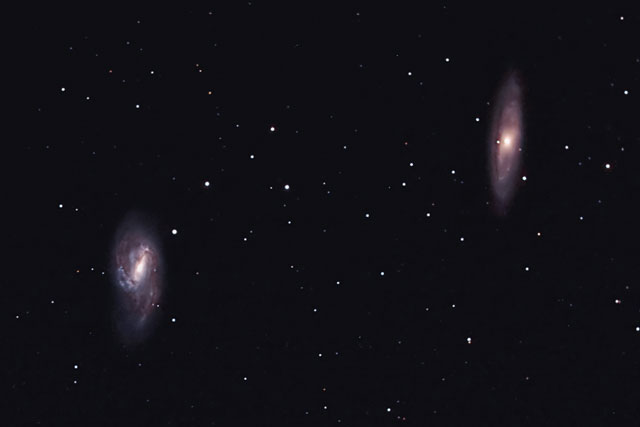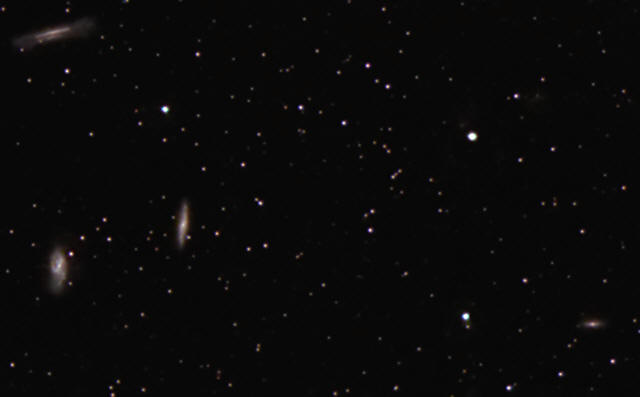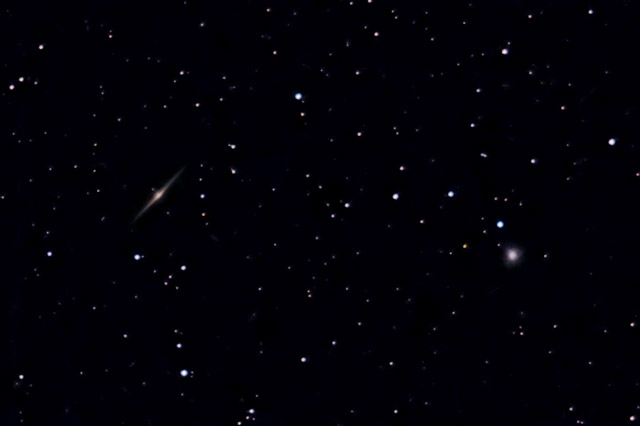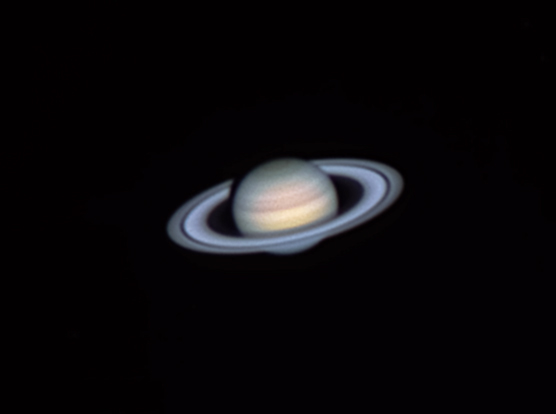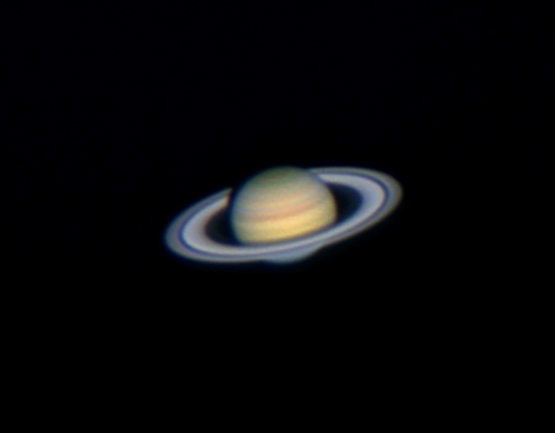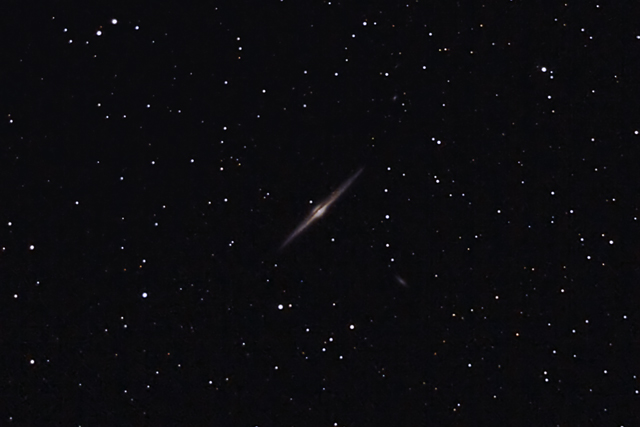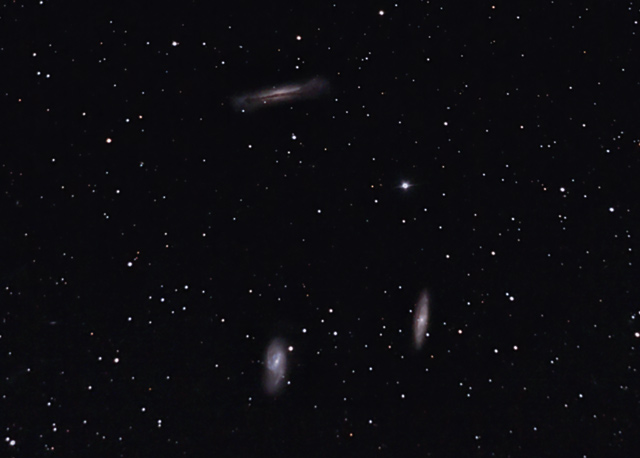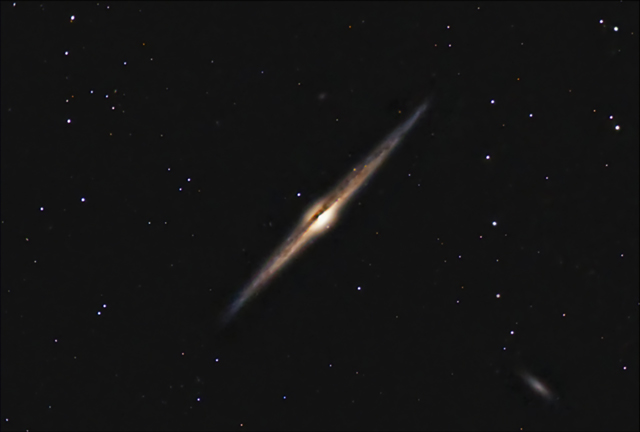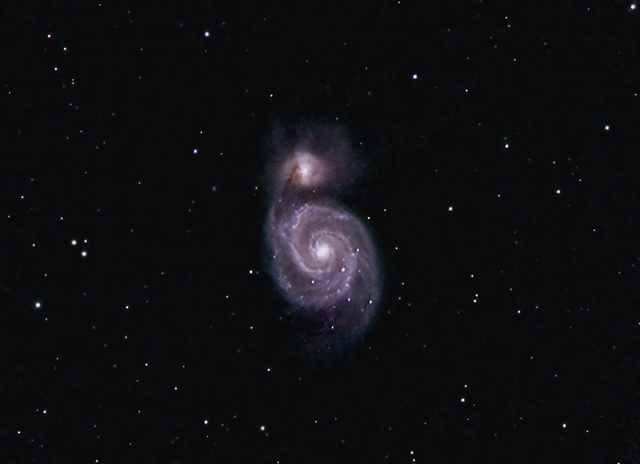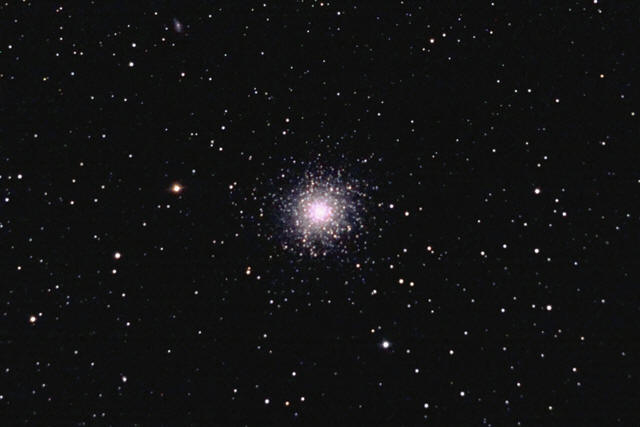______________________
and NGC-4565 Wide Field
|
Remember these guys from the beginning of last month? Well, I think I did a much better job on them this time. My focus was better and I managed to get a few more sub-images to combine. Also, check out the wide field view of the Leo Trio that I managed to get from the night before I took the one below. Oh, and let's not forget NGC-4565, an edge on galaxy in Coma Berenices. It is another wide field view that I did playing around with my 200mm F/2.8 telephoto lens. |
|
M65 & M66, two galaxies of the "Leo Trio." Imaged on 3/5/06. Celestron C-8, F/6.3 focal reducer, Hutech Type 1 modified Canon 350 XT. Exposure was 8x150 second sub-images at 1600 ISO processed and stacked in IRIS with dark, flat and bias calibration. Photoshop, RC-Astro's Gradient XTerminator and Noel Carboni's Astronomy Tools for post processing. Neat Image for noise reduction. |
|
Wide field view of the Leo Trio (M65, M66 & NGC-3628) and one of their close neighbors, NGC-3593. Imaged on 3/4/06. Canon 200mm F/2.8 telephoto lens with a 72mm Lumicon Deep Sky filter and a Hutech Type 1 modified Canon 350 XT. Guided piggyback on my C-8. Exposure was 42x60 second sub-images at 1600 ISO processed and stacked in IRIS with dark, flat and bias calibration. Photoshop, RC-Astro's Gradient XTerminator and Noel Carboni's Astronomy Tools for post processing. Neat Image for noise reduction. |
|
Wide field view of NGC-4565, an edge on spiral in Coma Berenices. A close neighbor, NGC-4494 is also in the frame to the right. Imaged on 3/4/06. Canon 200mm F/2.8 telephoto lens with a 72mm Lumicon Deep Sky filter and a Hutech Type 1 modified Canon 350 XT. Guided piggyback on my C-8. Exposure was 6x60 second sub-images at 1600 ISO processed and stacked in IRIS with dark, flat and bias calibration. Photoshop, RC-Astro's Gradient XTerminator and Noel Carboni's Astronomy Tools for post processing. Neat Image for noise reduction. |
______________________
Saturn on 3/8/06
RAW vs. Normal
|
In the continuing debate on whether a Toucam Pro in normal mode is better or worse than one in "RAW" mode, I present my own comparison of the two types of webcam captures. The subject of this comparison is of course, Saturn. I imaged it on a night of good seeing, about a 7 out of 10 rating. Well, which one you think looks better? LoL! |
|
Saturn imaged on 3/7/06, at 10:20pm and 11:16 pm CDT (3/8/06, 4:20UT and 5:16UT.) South is up. Celestron C-8, Televue 2.5X Barlow and a Toucam Pro 740k webcam mounted via a Meade Flip Mirror system on the mirror side. The top image is the Toucam Pro in "RAW" mode, and was 500 frames acquired and stacked in K3CCDTools. The bottom image is normal mode and was also acquired and stacked in K3 with 300 images used. Photoshop, and Noel Carboni's Astronomy Tools for post processing. Neat Image for noise reduction. |
______________________
NGC-4565 & The Leo Trio
with a 5.5" F/3.6
Celestron Comet Catcher
|
I have been wanting to image some galaxies with my Celestron Comet Catcher since I got the scope. On Tuesday, March 21, 2006 I finally got my chance. It was a little windy when I took this image, but all in all it is not too bad. |
|
NGC-4565 on 3/21/06 taken with a Celestron Comet Catcher 500mm F/3.6 and a Hutech Type 1 modified Canon 350 XT. Guided piggyback on my C-8. Exposure was 16x60 second sub-images at 1600 ISO processed and stacked in IRIS with dark, flat and bias calibration. Photoshop, RC-Astro's Gradient XTerminator and Noel Carboni's Astronomy Tools for post processing. Neat Image for noise reduction. |
|
All three galaxies of the Leo Trio on 3/21/06. Taken with a Celestron Comet Catcher 500mm F/3.6 and a Hutech Type 1 modified Canon 350 XT. Guided piggyback on my C-8. Exposure was 17x60 second sub-images at 1600 ISO processed and stacked in IRIS with dark, flat and bias calibration. Photoshop, RC-Astro's Gradient XTerminator and Noel Carboni's Astronomy Tools for post processing. Neat Image for noise reduction. |
______________________
|
This is the image of NGC-4565 I've been wanting to bag since I got my C-8 telescope! Just like with my Comet Catcher, I've been itching to use my C-8 for prime focus imaging of the best galaxies. On the night of Friday, March 24, 2006, I finally got my chance. Conditions were calm and still. The sky was very clear and transparent. I had trouble with guiding unfortunately and my yield of useable sub-images was low. But, there were enough to get a decent picture. I really wanted it to look better so I took 17 more sub-images on the following Saturday night and added them to the ones from the night before. Here is the result: |
|
NGC-4565 on 3/25/06 and 3/26/06 taken with a Celestron C-8 at F/6.3 (1260mm.) Guided with a Meade DSI and 100mm F/5 refractor. Hutech Type 1 modified Canon 350 XT used with 30x150 second sub-images at 1600 ISO. Processed and stacked in IRIS with dark, flat and bias calibration. Photoshop, RC-Astro's Gradient XTerminator and Noel Carboni's Astronomy Tools for post processing. Neat Image for noise reduction. Click here to see the full size hi-res version. |
______________________
M51 - The Whirlpool Galaxy
at C-8 Prime Focus
|
A very long time ago, I photographed this far away galaxy. LoL! It was the mid-1980's, and I was using Fujichome 400 hypersensitized film with exposures of about 20 to 30 minutes. Boy, that was a chore. I had to hyper my own film, setup the scope for the shot and stay hunched at the eyepiece until I was practically blind. Then, I had to develop these little pieces of slide film as a negative myself, because the photolab had no clue what to do with this kind of stuff. Ahh, the good ole days! Now, with my digital camera and a laptop computer guiding my shots, I can get images ten times better with half the work and no chemical mess! And I can see my results almost instantly. |
|
M51 - The Whirlpool Galaxy on 3/26/06. Imaged with a Celestron C-8 at F/6.3 (1260mm) and a Hutech Type 1 modified Canon 350 XT . Guided with a Meade DSI and 100mm F/5 refractor. 15x150 second sub-images at 1600 ISO. Processed and stacked in IRIS with dark, flat and bias calibration. Photoshop, RC-Astro's Gradient XTerminator and Noel Carboni's Astronomy Tools for post processing. Neat Image for noise reduction. Click here to see the full size hi-res version. |
______________________
M13 - Globular Cluster
In Hercules
|
I imaged M13, a globular cluster in Hercules on 3/24/06. It was early in the morning when I took this image. Hercules was just about at the zenith near sunrise. |
|
M13 Globular Cluster in Hercules on 3/24/06. Imaged with a Celestron Comet Catcher at F/3.6 (500mm) and a Hutech Type 1 modified Canon 350 XT . Guided with a Meade DSI and C-8. 34x15 second sub-images at 1600 ISO. Processed and stacked in IRIS with dark, flat and bias calibration. Photoshop, RC-Astro's Gradient XTerminator and Noel Carboni's Astronomy Tools for post processing. Neat Image for noise reduction. Click here to see the full size hi-res version. |
